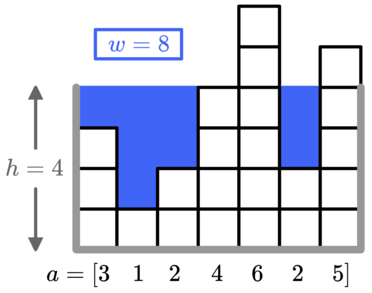310703: CF1873E. Building an Aquarium
Description
You love fish, that's why you have decided to build an aquarium. You have a piece of coral made of $n$ columns, the $i$-th of which is $a_i$ units tall. Afterwards, you will build a tank around the coral as follows:
- Pick an integer $h \geq 1$ — the height of the tank. Build walls of height $h$ on either side of the tank.
- Then, fill the tank up with water so that the height of each column is $h$, unless the coral is taller than $h$; then no water should be added to this column.

The first line contains a single integer $t$ ($1 \leq t \leq 10^4$) — the number of test cases.
The first line of each test case contains two positive integers $n$ and $x$ ($1 \leq n \leq 2 \cdot 10^5$; $1 \leq x \leq 10^9$) — the number of columns of the coral and the maximum amount of water you can use.
The second line of each test case contains $n$ space-separated integers $a_i$ ($1 \leq a_i \leq 10^9$) — the heights of the coral.
The sum of $n$ over all test cases doesn't exceed $2 \cdot 10^5$.
OutputFor each test case, output a single positive integer $h$ ($h \geq 1$) — the maximum height the tank can have, so you need at most $x$ units of water to fill up the tank.
We have a proof that under these constraints, such a value of $h$ always exists.
ExampleInput5 7 9 3 1 2 4 6 2 5 3 10 1 1 1 4 1 1 4 3 4 6 1984 2 6 5 9 1 8 1 1000000000 1Output
4 4 2 335 1000000001Note
The first test case is pictured in the statement. With $h=4$ we need $8$ units of water, but if $h$ is increased to $5$ we need $13$ units of water, which is more than $x=9$. So $h=4$ is optimal.
In the second test case, we can pick $h=4$ and add $3$ units to each column, using a total of $9$ units of water. It can be shown that this is optimal.
In the third test case, we can pick $h=2$ and use all of our water, so it is optimal.
Output
你打算建造一个养鱼缸,围绕一块由n列珊瑚建造。珊瑚的第i列高a_i单位。按照以下步骤建造鱼缸:
1. 选择一个整数h≥1——鱼缸的高度。在鱼缸两侧建造高度为h的墙。
2. 然后将鱼缸装满水,使每列的高度都是h,除非珊瑚高于h;那么这个柱子就不应该加水。
输入数据格式:
第一行包含一个整数t(1≤t≤10^4)——测试用例的数量。
每个测试用例的第一行包含两个正整数n和x(1≤n≤2*10^5;1≤x≤10^9)——珊瑚的列数和你可以使用的最大水量。
每个测试用例的第二行包含n个空格分隔的整数a_i(1≤a_i≤10^9)——珊瑚的高度。
所有测试用例的n之和不超过2*10^5。
输出数据格式:
对于每个测试用例,输出一个正整数h(h≥1)——鱼缸可以达到的最大高度,以便你最多使用x单位的水来装满鱼缸。
样例输入输出:
输入:
5
7 9
3 1 2 4 6 2 5
3 10
1 1 1
4 1
1 4 3 4
6 1984
2 6 5 9 1 8
1 1000000000
1
输出:
4
4
2
335
1000000001
注意:
第一个测试用例在题目描述中有图示。当h=4时,我们需要8单位的水,但如果h增加到5,我们需要13单位的水,这超过了x=9。所以h=4是最优的。
在第二个测试用例中,我们可以选择h=4,并且向每列添加3单位的水,总共使用9单位的水。可以证明这是最优的。
在第三个测试用例中,我们可以选择h=2,并且使用我们所有的水,所以这是最优的。题目大意: 你打算建造一个养鱼缸,围绕一块由n列珊瑚建造。珊瑚的第i列高a_i单位。按照以下步骤建造鱼缸: 1. 选择一个整数h≥1——鱼缸的高度。在鱼缸两侧建造高度为h的墙。 2. 然后将鱼缸装满水,使每列的高度都是h,除非珊瑚高于h;那么这个柱子就不应该加水。 输入数据格式: 第一行包含一个整数t(1≤t≤10^4)——测试用例的数量。 每个测试用例的第一行包含两个正整数n和x(1≤n≤2*10^5;1≤x≤10^9)——珊瑚的列数和你可以使用的最大水量。 每个测试用例的第二行包含n个空格分隔的整数a_i(1≤a_i≤10^9)——珊瑚的高度。 所有测试用例的n之和不超过2*10^5。 输出数据格式: 对于每个测试用例,输出一个正整数h(h≥1)——鱼缸可以达到的最大高度,以便你最多使用x单位的水来装满鱼缸。 样例输入输出: 输入: 5 7 9 3 1 2 4 6 2 5 3 10 1 1 1 4 1 1 4 3 4 6 1984 2 6 5 9 1 8 1 1000000000 1 输出: 4 4 2 335 1000000001 注意: 第一个测试用例在题目描述中有图示。当h=4时,我们需要8单位的水,但如果h增加到5,我们需要13单位的水,这超过了x=9。所以h=4是最优的。 在第二个测试用例中,我们可以选择h=4,并且向每列添加3单位的水,总共使用9单位的水。可以证明这是最优的。 在第三个测试用例中,我们可以选择h=2,并且使用我们所有的水,所以这是最优的。